Embark on an unforgettable journey through maritime history at Titanic Belfast, the world’s largest Titanic visitor experience. Located on the very site where the iconic ship was constructed, Titanic Belfast offers a comprehensive exploration of the ship’s history, its tragic voyage, and the city’s rich maritime heritage. Prepare to be captivated by the fascinating stories, immersive exhibits, and stunning architecture that awaits you.
Key Takeaways
Explore the birthplace of RMS Titanic at Titanic Belfast, featuring interactive galleries, gantry rides and reconstructions.
Discover historic slipways and the Maritime Mile with its SS Nomadic ship museum & HMS Caroline warship attraction.
Enjoy festive fayres, educational opportunities and special events for a memorable experience.
Journey to the Birthplace of RMS Titanic
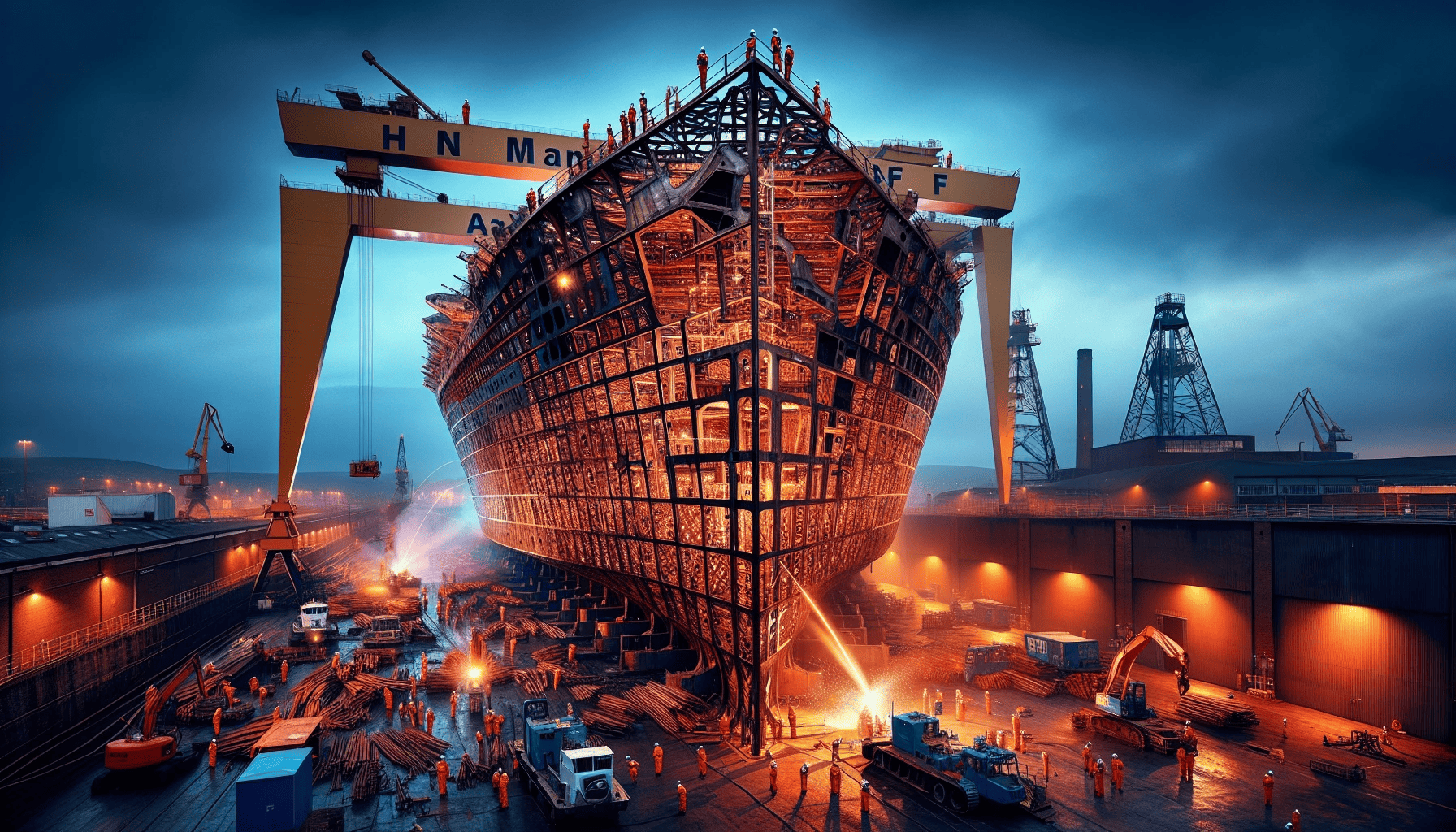
Titanic Belfast, an exceptional attraction, is located in the historic Titanic Quarter of Belfast, Northern Ireland, on the site of the former Harland and Wolff shipyard, the birthplace of the RMS Titanic. This globally recognized visitor attraction narrates the story of the famous ship, from its conception and construction to its tragic sinking and its rediscovery in 1985, using captivating audiovisual presentations, life-size reconstructions, interactive exhibits, and a ‘Shipyard Ride’.
The Titanic Experience
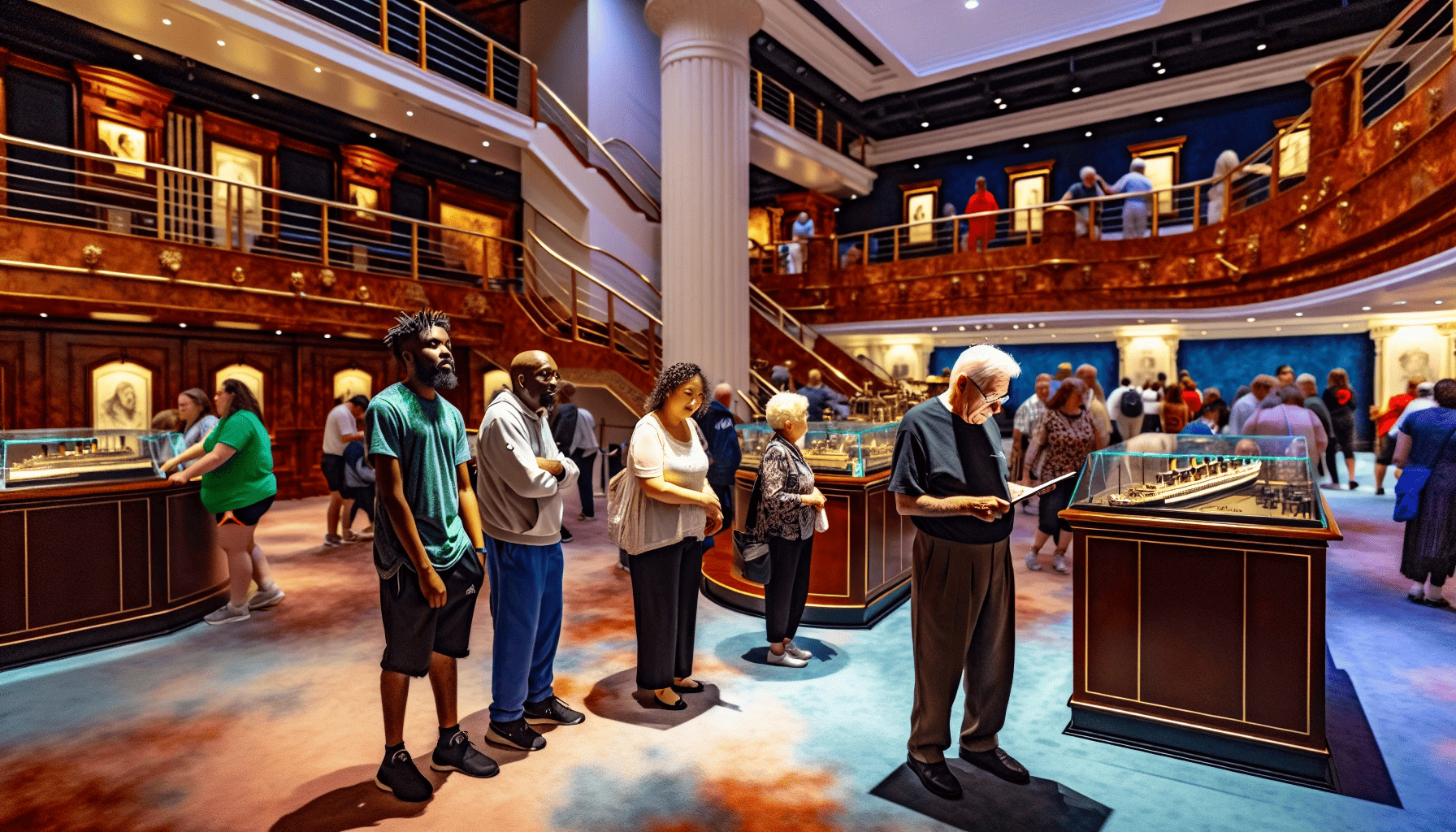
The Titanic Experience is an intriguing tour that plots the birth, launch, and untimely end of the Titanic. Visitors are invited to navigate through nine interactive galleries that follow the ship’s journey from its inception to its tragic demise, featuring gantry rides, touching artifacts, and striking cabin reconstructions.
The original Harland & Wolff gates act as the gateway to the Shipyard and mark the start of the Titanic Experience. Here, the ‘Jack and Rose’ pose offers a light-hearted, complimentary photo opportunity, symbolizing the end of the tour.
The Grand Atrium
The heart of Titanic Belfast is the Grand Atrium, a five-storey-high glazed atrium located at the center of the building, providing visitors with access to each of the nine galleries contained within the museum.
Inspired by the gangways, gantries, and cranes that filled the void between the Titanic and Olympic, the Grand Atrium reflects the grandeur of the RMS Titanic through its iconic design and advantageous location.
The History Of The Titanic
History of Titanic
Now we move to the history of Titanic. Here we will run you through some of the key events and people involved with the Titanic especially as it relates to Northern Ireland.

Titanic
The Titanic was conceived at a dinner party in a London mansion one fateful evening in 1907. There two men met, Bruce Ismay, who was Chairman of White Star Lines, and Lord James Pirrie who was Chairman of Harland and Wolff. The topic of the discussion was luxury travel in the oceans. The two of them agree to build a new class of liner that would be the ultimate in luxury and elegance. And so the history of Titanic began.
The actual work on the class of ships started on the Olympic, the Titanic’s sister ship, in December 1908 and completed in 1910.
The Construction of the Titanic
Work on the Titanic began in March 1909 and completed in 1912. A third ship, the Britannic, larger than the previous two but belonging to the same Olympic class, was completed in 1914. Harland and Wolff was chosen not only because it had the largest shipyard in the world, a fitting place to build what would then be the world’s largest liner. It was also a sign of the close co-operation of the two companies. Indeed, Harland and Wolff eventually built a total of 70 liners for White Star Line. These three Olympic class liners were build to compete with the equally luxurious and fast Mauritania and Lusitania of the rival Cunard Line company.
The site where the Titanic was built can be seen in Belfast harbour and is being developed into a historic monument. Three thousand Northern Irish workers worked on the construction of the Titanic out of a total of 15,000 workers in Harland and Wolff. The Titanic hull was launched on May 31, 1911. Thousands of residents gathered to cheer it along. It was a momentous day. Here is how a local newsletter reported it:
“The ship glided down to the river with a grace and dignity which for the moment gave one the impression that she was conscious of her own strength and beauty, and there was a roar of cheers as the timbers by which she had been supported yielded to the pressure put upon them. She took to the water as if she was eager for the baptism.”
She was outfitted by March 1912. On April 2, 1912 she set sail from Belfast for Southampton. The history of Titanic construction would be incomplete without a brief reference to lifeboats.
The Construction of the Titanic – Lifeboats
Why didn’t the titanic lifeboats suffice for all passengers? This is a question many people ask. At the time the Titanic was being built Board of Trade regulations required that ships over 10,000 tons carry 16 lifeboats and also enough rafts and floats for an additional capacity of 50% the capacity of the lifeboats (or 75% if there were no watertight compartments on the ship). The problem was that the regulations were fast becoming outdated. When the regulations had been set in 1894 the largest ships displaced a mere 13,000 tons, whereas the Titanic displaced a full 46,328 tons.
The titanic carried 16 lifeboats plus four folding ones called Collapsibles and so was within regulations but did not carry enough for all passengers and crew when fully loaded. Alexander Carlisle who had been chief draughtsman at the initial stages of construction had suggested 48 lifeboats be carried but because of objections the suggestion was never carried out.
The Titanic Band
The Titanic music band added a sense of heroism to this tragic event. Witnesses agree that the band played on till the end and it is certain that their memory will live as a memorial for generations to come.
The key person in the Titanic music band was Wallace Hartley. He was born in Colne, Lincoshire, could play the violin well, and had worked for years as a musician on ocean liners. On the Titanic band he was the leader of a quintet and their job was to play at church services and during tea and after dinner. In addition to Hartley’s five there was a trio who played at the reception hall. They played a piano, cello and violin. The two groups worked separately but on the night of the sinking joined together, possibly for the first time.
Titanic Band – Music even as the boat is sinking
Why did the Titanic band play even as the boat was sinking? They hoped to keep the passengers calm and upbeat and also the crew who had the daunting task of organizing the lifeboats. In this respect their determination to continue playing in the freezing cold even as it became apparent that there was no hope for the boat of for them must surely mark these men as heroes.
Which was their last song?
Hartley had once said that if he was on a sinking ship he would want his last song to be either “Nearer My God to Thee”, a beautiful hymn composed by English Christian poet Sarah Adams; or “O God our Help in Ages Past” by the famous hymn composer and father of English hymnology, Isaac Watts. Survivors testified that the Titanic band played “Nearer My God to Thee”. This is what the newspapers reported and this is what was traditionally accepted in the years since the tragedy. Wireless operator Harold Bride by contrast, reported that the band’s last song was “Autumn”. Probably he meant either the hymn “Autumn” or the “Songe d’ Automne” which was popular at the time. Since none of the band members survived we will never know for sure, but “Nearer My God to Thee” is the one ingrained in the public consciousness. Below are the words of this hymn.
In their Memory
Hartley’s body was found two weeks after the disaster, still wearing the band uniform. It was sent by boat to England. His funeral was attended by about one thousand people while many more thousands lined the streets to pay their respects to his funeral procession. There is a memorial erected in Colne dedicated to him and also a plaque in his home in Dewsbury, West Yorkshire. There is also a plaque to the band’s memory naming all eight members in Liverpool’s Philarmonic Hall. And so, the journey that started with the construction of the boat in Belfast Northern Ireland, came to an end.
Nearer My God to Thee – Lyrics
Nearer, my God, to Thee, nearer to Thee!
E’en though it be a cross that raiseth me;
Still all my song would be nearer, my God, to Thee,
Nearer, my God, to Thee, nearer to Thee!
——-
Though like the wanderer, the sun gone down,
Darkness be over me, my rest a stone;
Yet in my dreams I’d be nearer, my God, to Thee,
Nearer, my God, to Thee, nearer to Thee!
——-
There let the way appear steps unto heav’n;
All that Thou sendest me in mercy giv’n;
Angels to beckon me nearer, my God, to Thee,
Nearer, my God, to Thee, nearer to Thee!
——-
The with my waking thoughts bright with Thy praise,
Out of my stony griefs Bethel I’ll raise;
So by my woes to be nearer, my God, to Thee,
Nearer, my God, to Thee, nearer to Thee!
——-
Or if on joyful wing, cleaving the sky,
Sun, moon, and stars forgot, upwards I fly,
Still all my song shall be, nearer, my God, to Thee,
Nearer, my God, to Thee, nearer to Thee!
Navigating to Titanic Belfast
Titanic Belfast is conveniently located; it takes only 5-10 minutes to reach by car from George Best Belfast City Airport. From Belfast International Airport, the drive takes 30 minutes..
Whether traveling by sea or by land, Titanic Belfast is readily accessible, promising a seamless start to your maritime journey.
Arrival by Sea
While there are no specific boat routes to reach Titanic Belfast, you may access the museum by taking a ferry to the Stena Line ferry port and then traveling to the location by car or on foot.
Historic ship rides to Titanic Belfast are also on offer, providing an engaging and immersive trip through Belfast’s seafaring history.
Land Routes
For those arriving by land, Titanic Belfast is easily accessible by car, train, or bus. The No.300 bus to the Europa bus depot and then the No.5A bus to Titanic Q are available to access Titanic Belfast.
Or, if you prefer to drive, simply follow the directions from Belfast city centre to Titanic Belfast, which is just a short drive away from Belfast city centre.
Unveiling the Maritime Mile
The Maritime Mile, a pathway encompassing the historic slipways and the SS Nomadic, provides an insight into Belfast’s vibrant seafaring heritage. Including the historic Sailortown area, Titanic Belfast, and the Thompson Dry Dock, the Maritime Mile is a must-visit destination for history enthusiasts and Titanic aficionados alike.
Historic Slipways
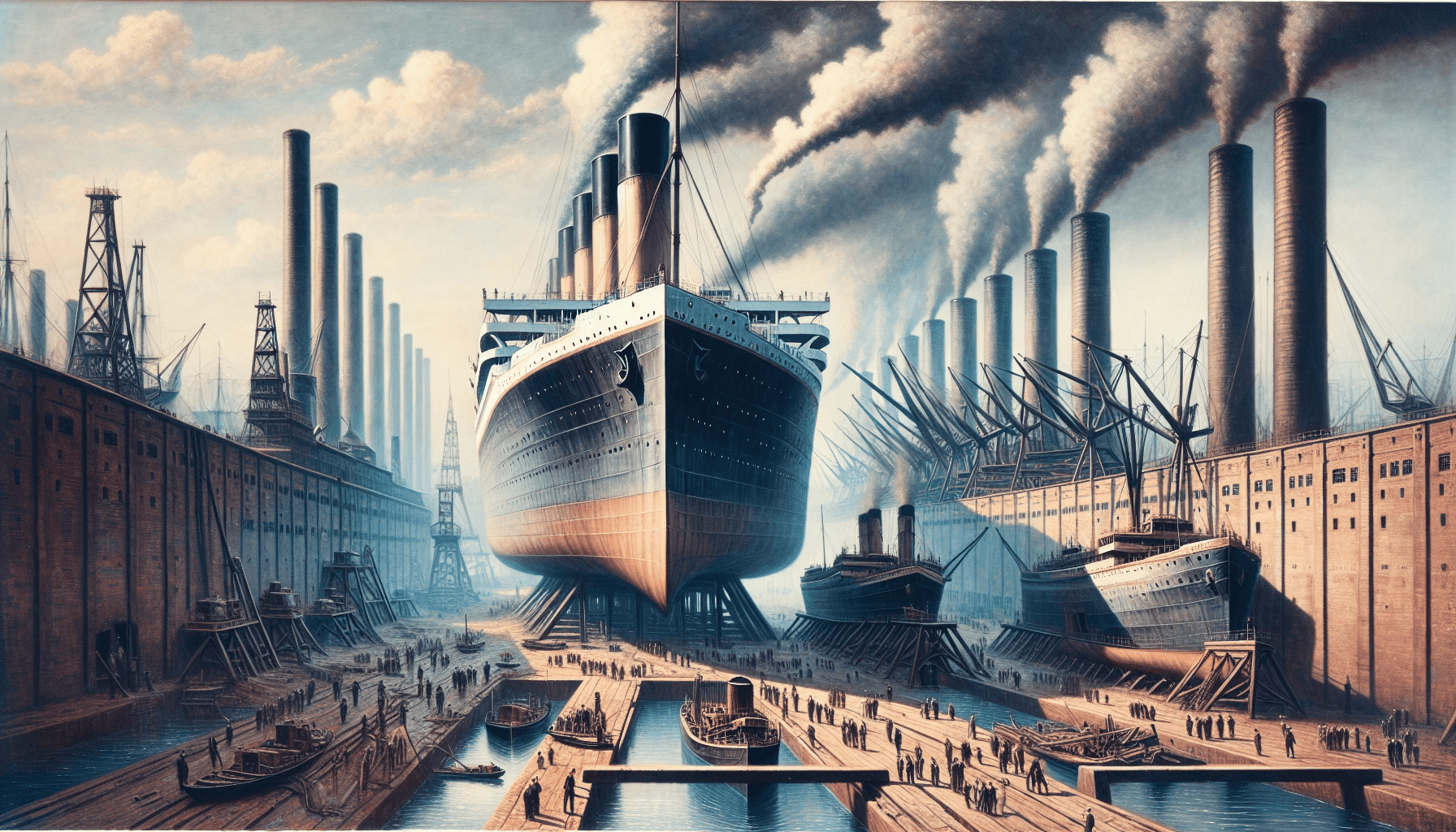
The historic Titanic slipways were the sites where the Titanic and its sister ship, the Olympic, were constructed and launched more than a century ago. These slipways have been restored and now serve as a venue for open-air concerts and events, providing a unique setting to experience Belfast’s maritime heritage.
The Great Light
Situated on the Titanic Walkway, a 500-meter maritime walkway on Victoria Wharf, the Great Light is one of the largest and most significant optics of its kind ever constructed. This 130-year-old marvel stands 7 meters tall and weighs 10 tonnes, serving as a powerful reminder of Belfast’s economic, maritime, and industrial history, as well as its connection to the Atlantic Ocean.
Accommodations with a Story
Round off your Titanic Belfast experience with an opulent stay at the Titanic Hotel Belfast, located in what used to be the headquarters of Harland & Wolff, the builders of the RMS Titanic. The hotel showcases the history and architecture of the White Star Line, narrating the story of Belfast’s shipbuilding and maritime history.
Titanic Hotel Belfast
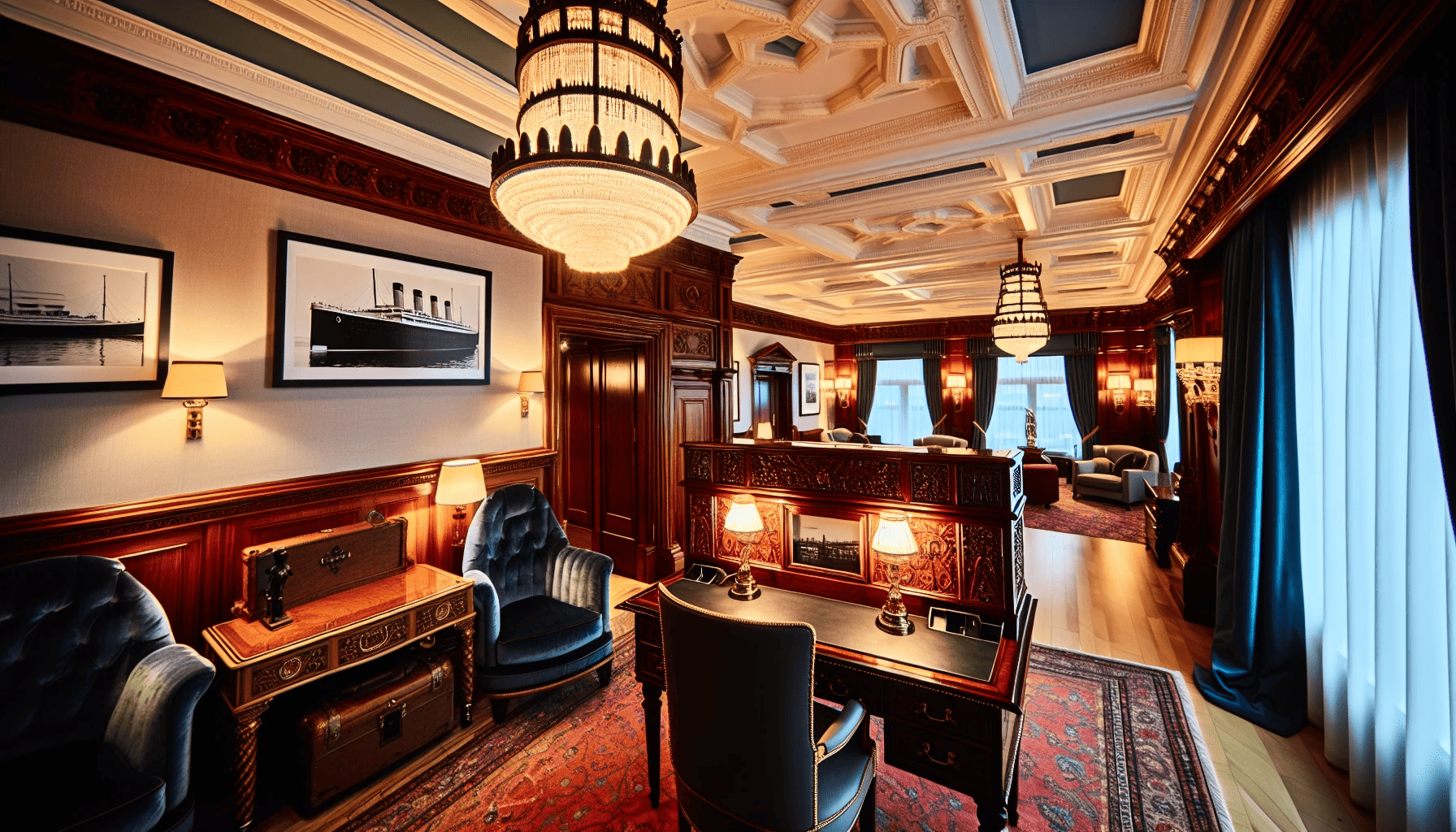
Experience the transformed Harland & Wolff headquarters through a luxurious stay at the Titanic Hotel Belfast. The hotel features:
Nautical-themed bedrooms with Art Deco furniture and maritime artwork
More than 500 Titanic artifacts, photographs, and artworks on display
A lobby with the Telephone Exchange, which was the communications hub of Harland & Wolff.
Enjoy fine dining at The Wolff Grill or indulge in a sumptuous afternoon tea during your stay.
Exploring Beyond the Ship
Extend your exploration beyond Titanic Belfast to uncover the city’s other nautical attractions, such as the SS Nomadic – the last remaining White Star Line vessel – and HMS Caroline, a World War One warship now serving as a floating museum.
SS Nomadic: The Last Surviving Ship
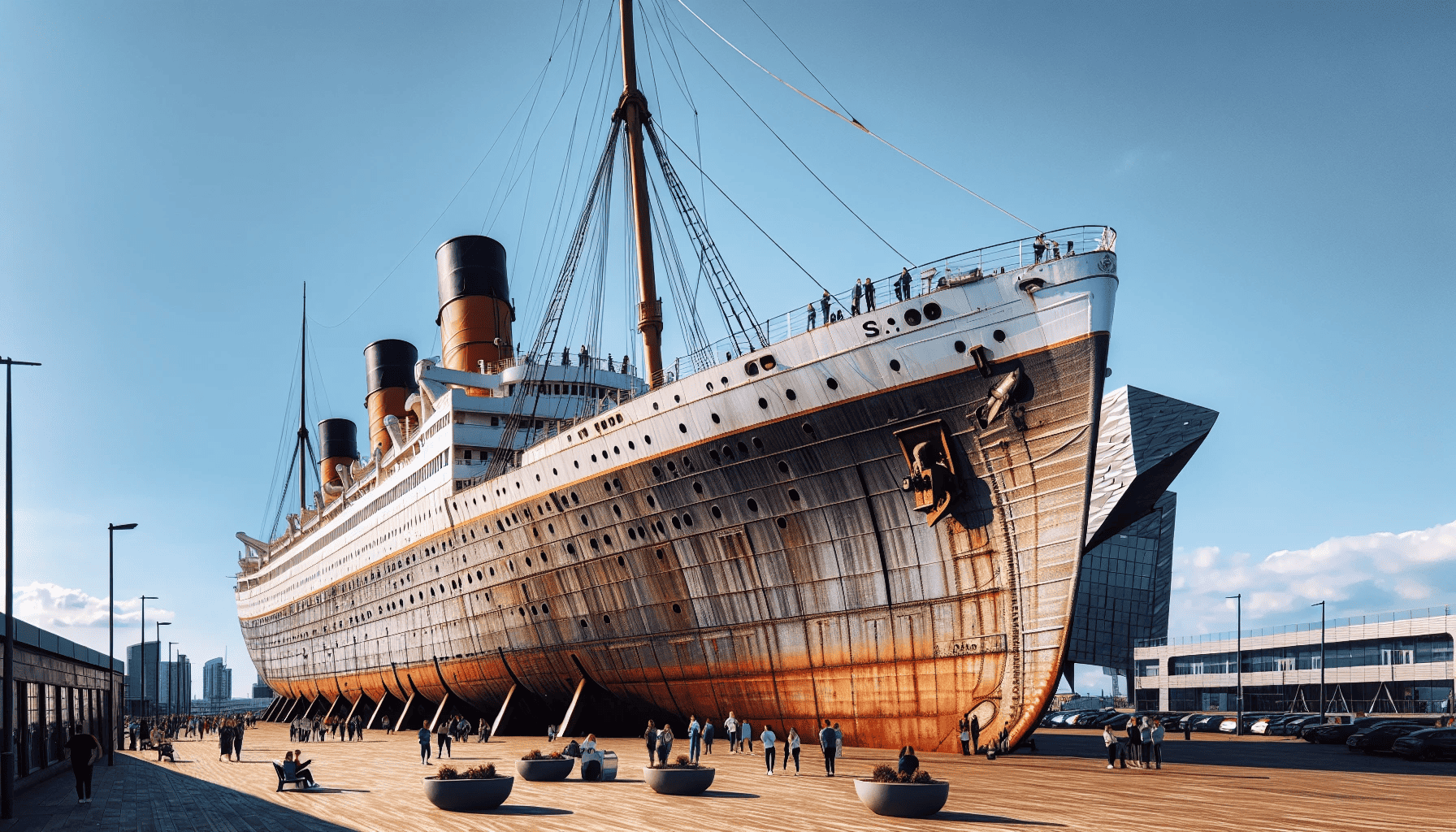
The SS Nomadic, the last surviving White Star Line vessel, offers an authentic maritime experience for visitors of all ages.
Designed by the renowned naval architect Thomas Andrews
Constructed in Belfast by Harland and Wolff
Served as a tender for the White Star Line’s luxurious ocean liners, including the doomed ocean liner, RMS Titanic, on its maiden voyage
Today, the SS Nomadic is situated at Hamilton Dock in the Titanic Quarter of Belfast, where visitors can explore its rich history.
HMS Caroline: A Warship’s Tale
Discover the fascinating story of HMS Caroline, a World War One warship that has been converted into a floating museum. As the only surviving ship from the Battle of Jutland in 1916, HMS Caroline offers an immersive experience into naval warfare and its role in World War I.
Located in the Titanic Quarter of Belfast, the HMS Caroline is a must-visit attraction for maritime history enthusiasts.
Delights for the Senses
Treat your taste buds and enjoy some leisurely shopping at Titanic Belfast’s Galley Café and Destination Bar, as well as the Titanic Store.
Galley Café & Destination Bar
Enjoy a delicious meal or grab a refreshing drink at the nautical-themed Galley Café & Destination Bar in Titanic Belfast. With a ‘grab and go’ selection using local and seasonal ingredients, the Galley Café offers a range of soups, sandwiches, and traditional sweet pastries.
The Destination Bar serves hot drinks, bottled beers, wines, and soft drinks to complement your meal.
Titanic Store: Souvenirs and More
Take a piece of history home with you from the Titanic Store in Belfast. With a wide range of unique souvenirs and memorabilia, you’ll find the perfect memento to remember your visit to Titanic Belfast.
Popular items include clothing, model ships, keychains, mugs, and books related to the Titanic.
Ensuring Accessibility for All
Titanic Belfast is dedicated to making its globally recognized attraction accessible to all, guaranteeing everyone can relish the complete Titanic Experience. Through the stories and exhibits, Titanic Belfast tells the captivating tale of this iconic ship.
Facilities and Services
Titanic Belfast provides a range of facilities and services to cater to the needs of visitors with disabilities, including wheelchair accessibility, lifts between all floors, and seated rest spaces throughout the exhibition.
They also offer audio guides with integrated loop systems for visitors with impaired hearing, ensuring that everyone can fully engage with the Titanic Experience.
Visiting with Assistance
For visitors requiring additional support, Titanic Belfast is more than happy to accommodate. Guide dogs and service animals are welcome, and wristbands for visitors with Autism Spectrum Disorder (ASD) are available upon request.
The Titanic Belfast staff is also trained to provide assistance to visitors with disabilities, ensuring a smooth and enjoyable visit.
Special Events and Seasonal Highlights
Titanic Belfast hosts a variety of special events and seasonal highlights throughout the year, injecting a dose of thrill and diversity into your visit.
Festive Fayre and Seasonal Tours
During the holiday season, Titanic Belfast offers a magical Christmas experience, featuring festive decorations, seasonal music, and special exhibits related to the holiday season. Enjoy the enchanting atmosphere as you explore the iconic ship and learn about its history in a festive setting.
The Festive Fayre at Titanic Belfast showcases the talent of local artisans and supports small businesses in Northern Ireland, offering a variety of handmade products for a unique holiday shopping experience.
Educational Opportunities
Titanic Belfast serves not only as an entertaining attraction but also as a significant educational platform, offering a multitude of learning opportunities for visitors across all age groups.
Learning Through Interactive Galleries
The interactive galleries at Titanic Belfast provide an engaging and immersive learning experience for visitors of all ages, covering a wide range of historical subjects related to the Titanic. Through full-scale reconstructions, special effects, and interactive displays, visitors can gain a deeper understanding of the history, tragedy, and legacy of the RMS Titanic.
Planning Your Visit
To fully enjoy your Titanic Belfast experience, it is advisable to plan your visit ahead of time, reserve your place, and guarantee a stress-free journey.
Book Tickets in Advance
Booking your tickets to Titanic Belfast in advance is highly recommended, particularly during peak tourist seasons. By reserving your tickets online, you can guarantee your desired date and time, ensuring a smooth and enjoyable visit.
Know Before You Go
Before embarking on your Titanic Belfast adventure, gather essential information about the attraction’s operating hours, ticket prices, and accessibility features. This will help ensure a hassle-free visit and allow you to fully immerse yourself in the Titanic Experience.
Summary
Titanic Belfast offers a comprehensive and unforgettable journey through maritime history, exploring the iconic ship’s creation, tragic voyage, and the city’s rich maritime heritage. With engaging exhibits, stunning architecture, and a range of special events and educational opportunities, Titanic Belfast is a must-visit destination for history enthusiasts, families, and travelers alike. Don’t miss the chance to experience this world-class attraction and delve into the captivating story of the Titanic.
Frequently Asked Questions
Is Titanic Belfast worth visiting?
Titanic Belfast is a must-see destination and is definitely worth the visit. Its nine galleries feature interactive exhibitions, original artefacts, and captivating stories, offering an unforgettable experience.
Can you see the Titanic in Belfast?
You can see the Titanic in Belfast through the self-guided Titanic Experience. Discover the world-famous story of the famous ship, and the people and city that made her, all while uncovering the sights, sounds, smells and stories of the ship.
Why is Belfast famous for Titanic?
Titanic Belfast® is the world’s largest Titanic visitor experience and is located in the place where Titanic was designed, built and launched. It boasts a spectacular external facade with 3,000 individual silver anodized aluminum shards and the longest freespan escalator on the island. Visitors can explore Slipways, Harland & Wolff Drawing Offices and Hamilton Graving Dock to learn more about the famous ship.
How much is it to visit the Titanic in Belfast?
Visiting the Titanic in Belfast costs around £25-£30 for an adult, and a bit less for a child. The admission fee includes entrance to both the Titanic Experience and the SS Nomadic.
Why is Titanic Museum in Belfast closed?
Due to the need to push boundaries with immersive technology, original maritime heritage and authentic Titanic story to create an enriched, emotive visitor experience, Titanic Belfast building is closing from 2nd January – 3rd March.

